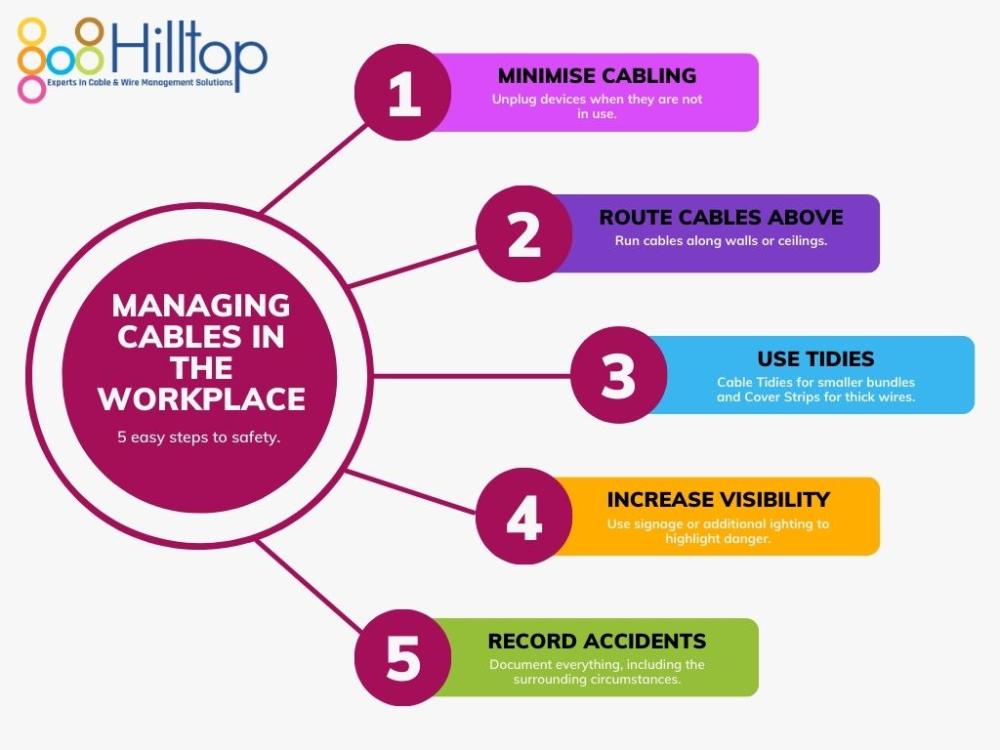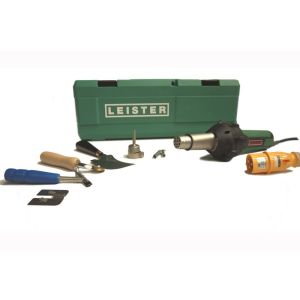Slips, trips, and falls account for about a third of employee injuries in the workplace and they are the leading cause of non-fatal workplace injuries.
Here's a quick guide and handy, printable reminder graphic to help you get to grips with your workplace's cabling.
Cable management safety – what are your responsibilities?
According to the Health and Safety Executive (HSE), in 2020/21, Great Britain had 51,211 reported injuries. 16,698 of these were due to slips, trips, or falls at ground level and it’s a fair assumption that tripping over trailing and untidy cables makes up a good chunk of these accidents.
Despite these not being falls from a height, the injuries can be serious. Tripping over cables that are hanging over desks or across floors can lead to fractures, head injuries, shoulder injuries and ankle damage, not to mention cuts and bruises.
How can you minimise the risk of cabling slips and trips?
A good starting point is to carry out a risk assessment in the workplace. Check out our quick RA guide to putting one together. This will help identify any issues to tackle, not just wiring problems.
Diligent and planned cable management is vital to avoid trips and falls, and there are plenty of products to help you do this.
Cable ties are simple and easy-to-use fastening tools that can be used to effectively bundle and secure wires and cables. Not only for the safety-minded, they help keep things more organised, with options for labelling and colour coding. They are durable and cost-effective.
Cable tidies, often referred to as cable organisers or cable management sleeves, are designed to wrap or encase multiple cables, consolidating them into a single sleeve or channel. Unlike cable ties, which bind cables together in a tight grip, cable tidies offer a more flexible and often reusable solution.
If you work in cable-heavy areas, such as construction sites, or even festivals and film sets, cable protectors, ramps and barriers help reduce the chance of an accident.
Spotting the hazards and negating them is mostly common sense, plus awareness and just general tidiness. But, there are some specific things you can do to reduce the risk of accidents.
- Minimize Unnecessary Cabling: Prevention is key. Reduce the amount of cabling by unplugging appliances or systems not in use. Ensure that cables are plugged in as close as possible to their destination to reduce the length of exposed wire.
- Route Cables Along Walls or Ceilings: To prevent tripping, run cables along walls or under solid objects. For permanent installations, consider routing cables up room corners and across ceilings.
- Use Cable Tidies or Cover Strips: There are various products available to keep cables organized and secured to the floor. Cable tidies are suitable for smaller bundles, while floor covers are ideal for thicker wiers in permanent instalaltions.
- Increase Visibility and Awareness: If there's still a potential tripping hazard after securing cables, use signage or additional lighting to highlight the danger. Even a simple floor lamp can help illuminate a hazardous area.
- Properly Record Any Accidents: If an accident occurs, it's crucial to document all details, including the circumstances leading up to the event, influencing factors, and the consequences. Proper documentation can help prevent future incidents.
Why not print out the following to help employees stay safe as part of your risk management process?


Other trip hazards to be aware of
It’s worth mentioning here that cabling isn’t the only cause of slips, trips in the workplace.
Uneven floor surfaces, whether slight differences in height or jutting objects such as floor covers, can be a significant trip hazard but, in some cases, you can improve visibility with tread markers. Worst case, you may need to refloor.
Laying a vinyl floor? Try the Altro kit for a perfect job
This is also true with wet and slippy floors. A non-slip, vinyl floor can be much safer.
Want more useful advice like this in your inbox once a week? Sign up to the Hilltop newsletter for tips and product offers. We promise not to spam you!




